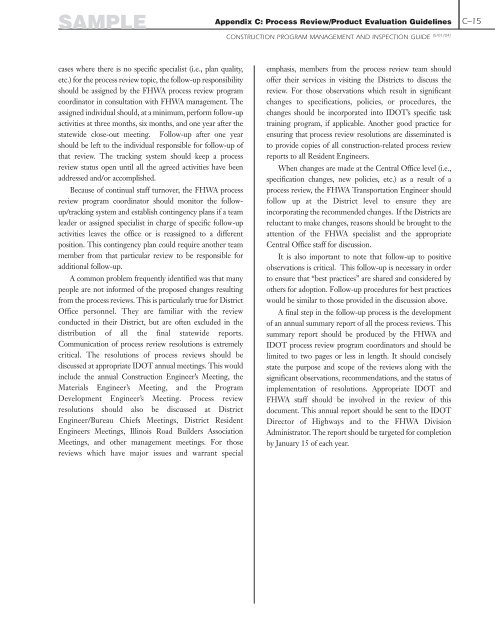Construction Program Management and Inspection Guide
Construction Program Management and Inspection Guide
Construction Program Management and Inspection Guide
You also want an ePaper? Increase the reach of your titles
YUMPU automatically turns print PDFs into web optimized ePapers that Google loves.
SAMPLE<br />
cases where there is no specific specialist (i.e., plan quality,<br />
etc.) for the process review topic, the follow-up responsibility<br />
should be assigned by the FHWA process review program<br />
coordinator in consultation with FHWA management. The<br />
assigned individual should, at a minimum, perform follow-up<br />
activities at three months, six months, <strong>and</strong> one year after the<br />
statewide close-out meeting. Follow-up after one year<br />
should be left to the individual responsible for follow-up of<br />
that review. The tracking system should keep a process<br />
review status open until all the agreed activities have been<br />
addressed <strong>and</strong>/or accomplished.<br />
Because of continual staff turnover, the FHWA process<br />
review program coordinator should monitor the followup/tracking<br />
system <strong>and</strong> establish contingency plans if a team<br />
leader or assigned specialist in charge of specific follow-up<br />
activities leaves the office or is reassigned to a different<br />
position. This contingency plan could require another team<br />
member from that particular review to be responsible for<br />
additional follow-up.<br />
A common problem frequently identified was that many<br />
people are not informed of the proposed changes resulting<br />
from the process reviews. This is particularly true for District<br />
Office personnel. They are familiar with the review<br />
conducted in their District, but are often excluded in the<br />
distribution of all the final statewide reports.<br />
Communication of process review resolutions is extremely<br />
critical. The resolutions of process reviews should be<br />
discussed at appropriate IDOT annual meetings. This would<br />
include the annual <strong>Construction</strong> Engineer’s Meeting, the<br />
Materials Engineer’s Meeting, <strong>and</strong> the <strong>Program</strong><br />
Development Engineer’s Meeting. Process review<br />
resolutions should also be discussed at District<br />
Engineer/Bureau Chiefs Meetings, District Resident<br />
Engineers Meetings, Illinois Road Builders Association<br />
Meetings, <strong>and</strong> other management meetings. For those<br />
reviews which have major issues <strong>and</strong> warrant special<br />
Appendix C: Process Review/Product Evaluation <strong>Guide</strong>lines<br />
CONSTRUCTION PROGRAM MANAGEMENT AND INSPECTION GUIDE (5/01/04)<br />
emphasis, members from the process review team should<br />
offer their services in visiting the Districts to discuss the<br />
review. For those observations which result in significant<br />
changes to specifications, policies, or procedures, the<br />
changes should be incorporated into IDOT’s specific task<br />
training program, if applicable. Another good practice for<br />
ensuring that process review resolutions are disseminated is<br />
to provide copies of all construction-related process review<br />
reports to all Resident Engineers.<br />
When changes are made at the Central Office level (i.e.,<br />
specification changes, new policies, etc.) as a result of a<br />
process review, the FHWA Transportation Engineer should<br />
follow up at the District level to ensure they are<br />
incorporating the recommended changes. If the Districts are<br />
reluctant to make changes, reasons should be brought to the<br />
attention of the FHWA specialist <strong>and</strong> the appropriate<br />
Central Office staff for discussion.<br />
It is also important to note that follow-up to positive<br />
observations is critical. This follow-up is necessary in order<br />
to ensure that “best practices” are shared <strong>and</strong> considered by<br />
others for adoption. Follow-up procedures for best practices<br />
would be similar to those provided in the discussion above.<br />
A final step in the follow-up process is the development<br />
of an annual summary report of all the process reviews. This<br />
summary report should be produced by the FHWA <strong>and</strong><br />
IDOT process review program coordinators <strong>and</strong> should be<br />
limited to two pages or less in length. It should concisely<br />
state the purpose <strong>and</strong> scope of the reviews along with the<br />
significant observations, recommendations, <strong>and</strong> the status of<br />
implementation of resolutions. Appropriate IDOT <strong>and</strong><br />
FHWA staff should be involved in the review of this<br />
document. This annual report should be sent to the IDOT<br />
Director of Highways <strong>and</strong> to the FHWA Division<br />
Administrator. The report should be targeted for completion<br />
by January 15 of each year.<br />
C–15

















